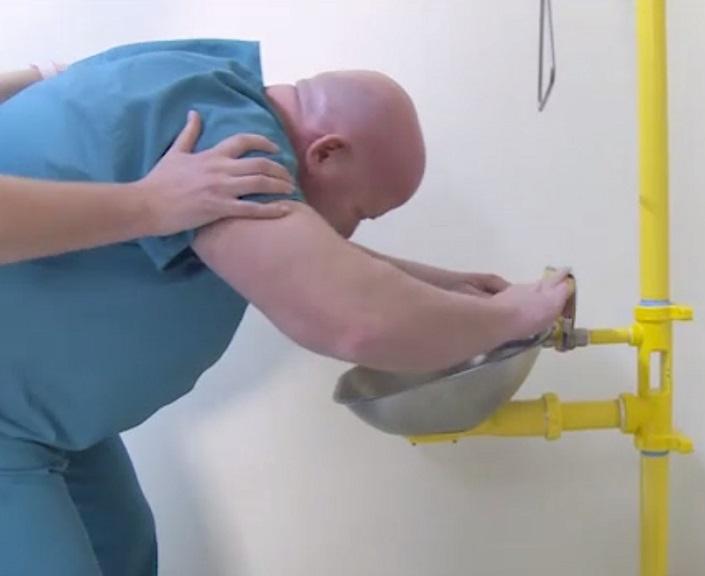How Proper Equipment and Training Can Save Lives
Workplaces that use hazardous materials have a responsibility to protect their employees from accidental exposures. Though companies implement policies and procedures to promote safe handling, the risk remains that corrosive or toxic substances can splash onto skin or into eyes. When this occurs, irreversible damage and serious injuries can result if the contaminant is not washed off immediately. The installation of emergency eyewash and shower stations, combined with proper training, provides the capability to take swift action that can prevent or reduce harm. This potentially life-saving equipment should be regarded as indispensable at facilities that handle risky materials.
The Dangers of Hazardous Materials
Hazardous substances pose many grave dangers to human health and physical integrity. Materials classified as irritants, such as solvents, can inflame skin, eyes, and respiratory passages. Toxic agents like insecticides, if absorbed into the body, can sicken, poison, and even kill. Some chemicals are corrosive and can burn or destroy living tissues and organs. Acids and caustics are notorious for their ability to rapidly damage eyes, skin, and other body parts. The threat intensifies when corrosives are mistakenly ingested, which can prove fatal.
Any hazardous material requires careful handling under controlled conditions. However, accidents sometimes happen, and these events underline the need for emergency washing facilities. A splash or spill that lands hazardous materials onto skin or into eyes starts the clock on an emergency. The longer the contaminant remains in contact with living tissue, the greater the harm inflicted. Immediate flushing and dilution of the chemical are required to lessen damage. Quick access to functioning and properly designed safety showers and eyewashes can mean the difference between a close call and a major injury, or even between survival and death.
Legal Requirements for Emergency Washing Equipment
The Occupational Safety and Health Administration (OSHA) recognizes the dangers of hazardous materials in the workplace and has codified requirements to safeguard employees. Under the agency’s standard on Hazard Communication, employers must make suitable emergency washing facilities available wherever employees may be exposed to corrosives. Safety showers, eyewashes, or combination units must be installed and tested regularly to ensure they work when needed. OSHA also mandates worker training so everyone knows how to reach the equipment in the facility and operate it appropriately. Workers should be prepared to find stations quickly even if vision is compromised by contaminants in the eyes. Practicing finding and using washing units blindfolded builds this crucial capability.
Though OSHA sets core safety requirements, the design specifications for emergency washing equipment derive from consensus standards published by the American National Standards Institute (ANSI). ANSI guidelines dictate that showers and eyewashes be situated no more than 10 seconds from any hazard area for rapid access. Stations must deliver tepid water, defined as 60°F to 100°F, at a minimum flow rate of 20 gallons per minute from showers and 0.4 gallons per minute from eyewashes. These parameters encourage users to wash thoroughly for the recommended 15 minutes without discomfort from freezing or scalding water. ANSI also specifies “hands-free” activation within one second to begin water flow, so users’ hands are free to assist eyes or undress beneath showers.
Using Emergency Washing Equipment Effectively
When accidental exposure occurs, quick thinking and instinctive actions are needed to utilize emergency washing stations to maximum benefit. If the face and eyes are contaminated, the first priority is always irrigating the eyes. With corrosives, every second counts, so the nearest eyewash must be reached immediately while calling for assistance. Eyes should be held open while rolling eyeballs around in the water flow to rinse completely under eyelids. Contact lenses should be removed promptly to avoid trapping chemicals. Eyes require a full 15 minutes of washing regardless of any early relief to ensure the contaminant has been diluted and flushed out.
For exposures covering larger body areas, emergency showers are critical for thorough decontamination. While calling for help, immediately get under the shower and drench contaminated clothing to dilute chemicals before rapidly disrobing down to bare skin. Assistance from co-workers may be needed to remove garments quickly. Wash and scrub all areas of the body vigorously while being careful to keep contaminants flushed off the body from entering the eyes. Remain under the spray for a full 15 minutes minimum.
After using eyewashes or showers, it is vital to seek proper medical treatment, both to assess injuries and determine if delayed effects are possible. Provide safety data sheets to medical personnel to aid diagnosis and treatment. Assistants who helped exposed colleagues should also rinse off themselves, and contaminated clothing must be disposed of or decontaminated before laundering.
Maintaining Equipment and Preparedness
Emergency washing units only fulfill their purpose if properly maintained. ANSI standards direct that facilities perform weekly activations to verify flow rate and water quality and check that paths to stations remain clear. Units should be inspected annually to confirm all components function per specifications. Water and fluid preservatives require periodic changing. Any identified issues must be corrected expeditiously.
Equally important as quality equipment is comprehensive worker preparation. All employees who may encounter hazards should be trained on locating emergency washing facilities throughout the workplace and recognizing hazardous materials that require flushing. Annual hands-on exercises reinforce how to appropriately use showers and eyewashes in the critical moments after exposure. Unannounced practice drills ensure readiness and quick reflexes to handle surprise incidents effectively.
Protecting Lives with the Right Equipment and Training
Preventing hazardous material accidents should always be the priority through rigorous safety policies and procedures. However, the mistake-proof workplace remains elusive, so employers must also furnish employees with the means to minimize harm when the unthinkable happens. Emergency washing facilities like showers and eyewashes are not just recommended—they are vital, life-saving equipment. Combine them with comprehensive training, and workers will have the tools and skills to take swift, appropriate actions if disaster strikes. By planning for the worst, companies can drastically improve outcomes and potentially save lives. The modest investment in proper emergency washing equipment and preparation pays unlimited dividends if an accident ever occurs.
The Dangers of Improperly Maintained Equipment
While emergency washing equipment is critical, it only functions as intended when properly maintained. ANSI standards direct facilities to test their emergency shower and eyewash stations on a weekly basis. This regular activation verifies that water flows at the minimum rate and temperature. Testing also confirms that nothing is obstructing access or visibility of the units.
In addition to weekly activations, ANSI mandates an annual inspection of all installation components. Any deficiencies found must be corrected quickly. The annual checks validate that spray heads provide adequate coverage, flow rates meet specifications, and valves activate appropriately.
Another key maintenance task is periodic flushing and refilling of fluid reservoirs. Water in self-contained eyewash units should be changed every six months at a minimum. Preserved buffered saline solutions, though more expensive, allow longer intervals between changes. But even these fluids must be replaced eventually when their buffering capability declines.
Neglecting preventive maintenance invites disaster. If emergency washing equipment fails to activate properly or run long enough when needed, the result could be devastating and permanent injuries or death. The minimal investment in proper inspection and upkeep is insignificant compared to the human suffering caused by poorly functioning safety equipment.
Proper Handling of Contaminated Waste
Use of emergency washing equipment inevitably generates hazardous waste that also requires appropriate handling. When safety showers or eyewashes are plumbed to drain, the wastewater produced may contain diluted yet still risky levels of contaminants. Facilities must ensure this effluent flows to proper wastewater treatment systems and not directly into sewers or the environment. Treatment may be necessary to remove toxins before wastewater can be discharged.
If washing stations drain into contained areas, the collected contaminated fluid also becomes hazardous waste. It must be disposed of properly according to hazardous waste regulations and a facility’s written plans. The same applies to clothing contaminated during exposure incidents. After use, eyewashes and showers should be decontaminated according to equipment instructions and safety data sheet guidelines to protect employees performing maintenance.
With training on their company’s hazardous waste policies, workers can adhere to the controlled procedures for collecting, containing, labeling, storing, transporting and disposing of dangerous materials. Careful handling protects both human health and the larger environment.
In a workplace where the threat of hazardous material exposure is real, the need for proper safety equipment is paramount. But without proper training, this equipment may go underutilized or misused. Our comprehensive “Safety Showers and Eye Washes” online training course goes beyond mere equipment provision, educating employees on how to effectively and instinctively respond to emergencies. Investing in this knowledge can mean the difference between tragedy and a close call.
Are you responsible for the safety of employees working with hazardous materials? Provide them with the knowledge and skills they need to handle emergency situations with our “Safety Showers and Eye Washes” full-length interactive online course. This course covers essential topics such as HAZMATs, safety showers, eye washes, and post-decontamination procedures. Designed with interactive elements, it ensures complete engagement and retention, turning crucial information into instinctive reactions. Equip your team to respond with confidence, because knowing how to use safety equipment properly isn’t just compliance—it’s lifesaving. Available in both English and Spanish, invest in safety today with our online training course. Let’s turn safety knowledge into safety action.


